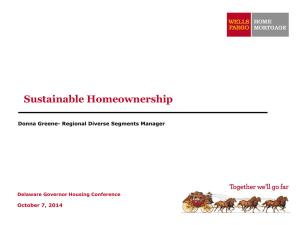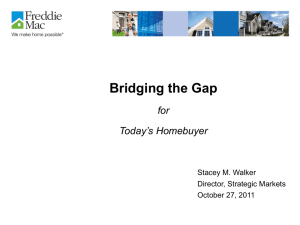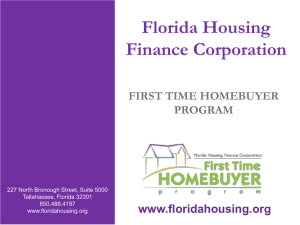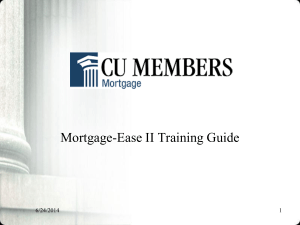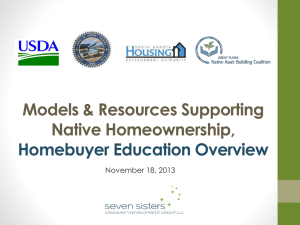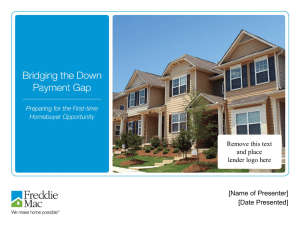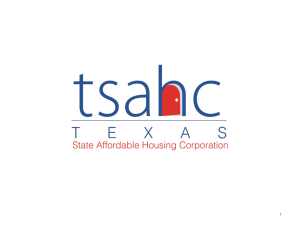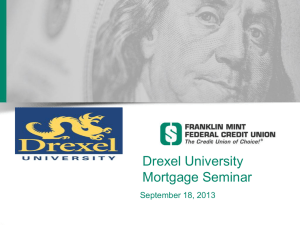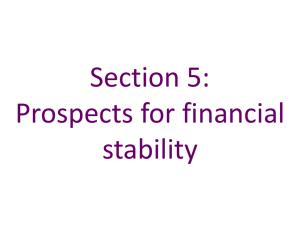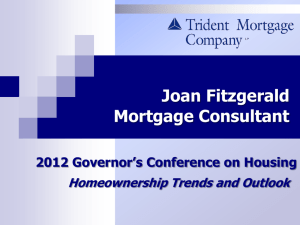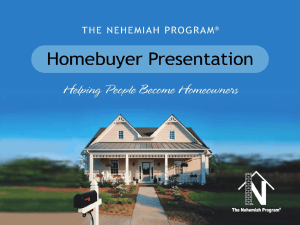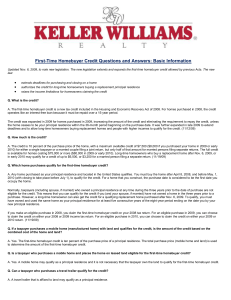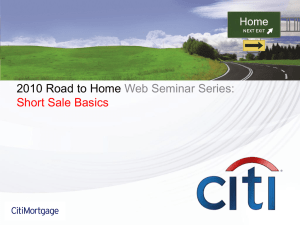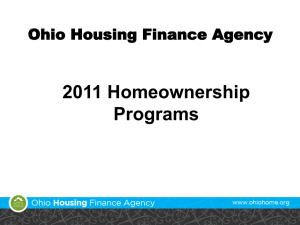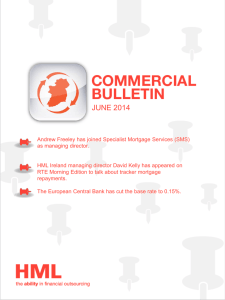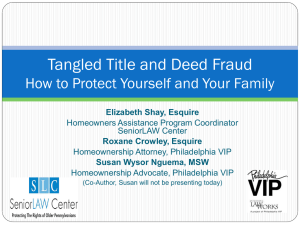First-Time Homebuyer
advertisement
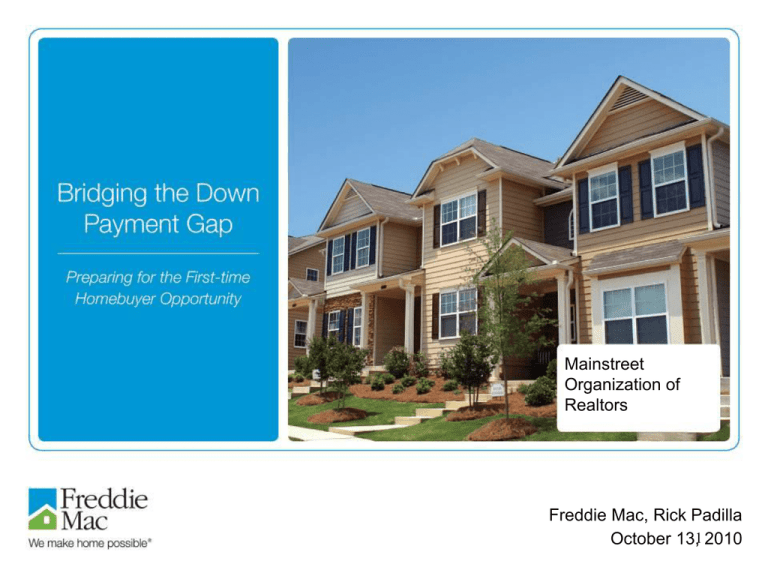
Mainstreet Organization of Realtors Freddie Mac, Rick Padilla October 13,1 2010 Today’s Presentation It’s a Great Time to Buy Today’s First-time Homebuyers Bridging the Gap: Down Payment and Closing Cost Resources Putting These Programs into Action for Your Business and Your Clients 2 It’s a Great Time to Buy! Low Interest Rates & Lower Home Prices Have Increased Homebuyer Affordability Percent Index 180 150 NAR Affordability Index 18.0 30-Year Fixed Mortgage Rate (right scale) 14.5 (left scale) 120 11.0 90 Forecast 4.0 1971 1973 1975 1977 1979 1981 1983 1985 1987 1989 1991 1993 1995 1997 1999 2001 2003 2005 2007 2009 2011 60 7.5 Index = 100 means median income buys median priced home Source: National Association of Realtors Composite Housing Affordability Index – (% of median priced home affordable on median income with conventional mortgage and 20% down), seasonally adjusted; Freddie Mac Primary Mortgage Market Survey ® and September 2010 Outlook. National House Prices Have Experienced a Cumulative Decline of 17% Since June 2006 6 5 4 3 2 1 0 -1 -2 -3 -4 -5 -6 -7 -8 Quarterly Growth Rates (Numbers in Percentages) 5.0 4.2 3.4 2.8 2.1 2.3 2.6 2.4 1.8 1.6 0.9 1.3 0.4 0.8 0.0 0.0 -0.6 -0.8 -1.3 -1.9 -2.0 -2.8 -2.6 -2.4 -4.1 -6.5 2004Q1 2004Q3 2005Q1 2005Q3 2006Q1 2006Q3 2007Q1 2007Q3 2008Q1 2008Q3 2009Q1 2009Q3 2010Q1 Note: National home prices use the internal Freddie Mac Index, which is a value-weighted based on Freddie Mac’s single-family portfolio. The US index is a monthly series; quarterly growth rates are calculated as a 3-month change based on the final month of each quarter. Source: Freddie Mac Housing Stock High at Lower Prices Source: Bureau of Census (1996-2004:Annual Data, 2005Q1–2009Q4:Quarterly Data) Note: The excess unsold homes were estimated based on the average vacancy rate from 1996Q1 to 2005Q4 (1.7%). 6 Market Drivers Influence Purchase Patterns Past Few Years (2005 – 2007) Today (2010) Consumers anxious to become homeowners to catch the appreciation wave Consumers waiting on the sidelines for prices to bottom out or the market to stabilize Minimal savings required for down payment Consumers unsure whom to trust Homeownership viewed as a short-term investment (Market Created Equity) Equity used as ATM for other purposes beyond homeownership Consumers took advantage of exotic low initial payment mortgages Savings now required for down payment and closing costs (5%-20%) Homeownership a longer term investment (Homebuyer Creates the Equity) Consumers feel unprepared for mortgage obligation Summary The demographic profile of homebuyers has not changed. The value proposition of becoming a homebuyer has changed for most consumers, resulting in a change in their behavior and approach toward homeownership. New value proposition is long-term investment versus short-term reward/ATM. Consumers seeking simple mortgage products with no surprises Given these changes, how do we attract, prepare, and serve well-qualified homebuyers going forward? 8 Borrower Segments Challenges Anxiety over housing prices Lack of down payment Inability to find financing Lack of information Lower equity in existing home Challenges of selling home Fear of declining house values Universal Fear of making wrong choices Fear of foreclosure Fear of unemployment Fear of continuing decline in home prices (investment loss) Not the right time to buy Monthly payment and cash upfront issues Repairing credit Fear of unemployment/foreclosure Lack of down payment Source: Freddie Mac Down payment struggles Costs are higher for credit scores from 620 –640 9 Who Are Today’s First-time Homebuyers? First-time Homebuyers Today 2009 Homebuyer Profile First-time Homebuyer – Demographic Characteristics Share increased from 41% in 2008 to 47% in 2009 Married couple represent 50% of FTHBs Repeat Buyer 53% First-time Homebuyer 47% Single female buyers represent 25% of FTHBs Single male buyers represent 12% of FTHBs First-time Homebuyer Demographics Other 1% Unmarried couple 12% Single male buyers 12% Married couple 50% Single female buyers 25% 11 Age of First-time Homebuyers Homebuyer Age First-time homebuyers are typically younger than repeat buyers. Age of Homebuyer 18–24 6% More than half of first-time homebuyers were between 25-44 years old. 25–34 34% Typical homebuyer is 39 years old (median age). 35–44 22% 45–54 18% 55–64 13% 65–74 6% 75 and over 2% National Association of Realtors Profile of Home Buyers and Sellers 2009 12 Projected Population 2010-2025 Projected Population Increase -- 2010-2025 40% (5.58%) (11.23%) (16.75%) Asian 25% (16.06%) (33.46%) (52.38%) 5% 0% White U.S. Census Data 2000 Black 14.65% 10% 16.75% 15% 11.23% 49,726 57,711 66,365 75,772 2010 2015 2020 2025 20% 5.58% (14.65%) (30.11%) (46.44%) 12.02% 14,415 16,527 18,756 21,109 Hispanic 2010 2015 2020 2025 30% 7.97% 2010 2015 2020 2025 35% 30.11% 39,909 42,137 44,389 46,594 3.92% 2010 2015 2020 2025 45% 33.46% Black 50% Asian 16.06% (3.92%) (7.97%) (12.02%) 46.44% 246,630 256,306 266,275 276,281 52.38% 55% White 2010 2015 2020 2025 Population Growth 2010–2025 Percentage Change Hispanic 13 Down Payment and Closing Cost Assistance Resources Sources of Funds • Assistance from a variety of sources is available for mortgageready, well-qualified first-time homebuyers who need a little bit more to bridge the gap: – Mortgage Credit Certificates; and – Down payment and closing cost assistance (grants and deferred seconds) offered through either HUD’s HOME Investment Partnerships Program or the Community Development Block Grant Program that are used to administer programs on the state or local level. Examples of such programs include the American Dream Downpayment Initiative and the Neighborhood Stabilization Program. – Assistance may be limited to first-time homebuyers and/or low and moderate-income homebuyers, depending on the assistance program. • Homebuyer education counseling is often required, but not always. Source – HUD and NCSHA 15 Types of Down Payment Assistance Grants • Grants are funds that do not have to be paid back, but often have to be paid back if the borrower sells his or home within a certain period of time. Deferred Seconds • Many down payment assistance programs come in the form of a second mortgage that has a low interest rate and/or deferred payments. Source -- HUD 16 Mortgage Credit Certificates • Issued by certain state or local governments (including state housing finance agencies), MCCs generally allow homeowners to claim around 20 percent of the annual interest on their mortgage as a federal tax credit every year for the life of the original first mortgage (details vary by state). • Amount of credit per mortgage loan capped by Internal Revenue Service @ $2,000 per year. • Mortgage lenders often use the estimated amount of the credit on a monthly basis as additional income to help the potential borrower qualify for the loan. Source – NCSHA and Wikipedia® 17 How Mortgage Credit Certificates Work Borrower receives an MCC for: 30% credit $200,000 mortgage 30-year, fixed-rate 6% interest rate Allowable Tax Credit: Mortgage Interest Paid (First Year): $11,933 X 0.30 (30% MCC Credit) = Total Credit: $3,579 Results: Total tax credit in this example exceeds IRS limit of $2,000 Homebuyer reports a $2,000 credit on tax return Homebuyer may continue to receive a tax credit for as long as they remain in home and retain mortgage For illustrative purposes only. Borrowers should always check with their tax advisor to determine any potential tax benefits. Source – Wikipedia® 18 How Government Grants and Loans Can Help Borrowers Buy Their First Home YOUR BORROWER’S NEW HOME First Mortgage FIRST MORTGAGE Obtain a 30-year fixedrate conventional mortgage and combine it with a Mortgage Credit Certificate to lower the borrower’s monthly payment and maximize his or her purchasing power. Borrower obtains a 30-year conventional fixed-rate loan + Mortgage Credit Certificate (MCC), when available Home Purchase Price + Closing Costs (about 3% of purchase price) __________________________ TOTAL REQUIRED TO CLOSE Money Out of Pocket Borrower’s personal contribution towards the purchase can be as low as 3% of the purchase price (5% for manufactured housing) MONEY OUT OF POCKET Borrower’s personal contribution. “Gap” Loan “GAP” LOAN These loans fill the gap between what you can qualify for on your own and the actual price of the home. These loans don’t require any monthly payments. Silent second loan from a local government agency requires no monthly payment and, therefore, is not counted as a borrower’s debt during underwriting Other Assistance Programs Remaining down payment or closing cost assistance needed to close the loan (can include seller concessions) OTHER ASSISTANCE PROGRAMS If the “gap” loan isn’t sufficient to close the loan, these programs give extra help with the borrower’s down payment and closing costs. Seller concessions can 19be applied here. Pulling this all together into a Plan to Grow Your Business: Outreach Efforts and Activities How Strategic Markets Helps You Build New Business and Sustain Homeownership Preserving Homeownership Creating Business Opportunities Preparing Borrowers for Homeownership Increase your presence with homeowners who may be eligible for a Making Home Affordable modification or refinance. We’ll partner with you at consumer events and work with you on new ways to reach consumers. Our team is strategically positioned to provide you with a set of unique resources and expertise to proactively help you achieve multiple business objectives. Strengthen your new business development strategy with solutions to assist you in reaching first-time homebuyers. 21 21 CreditSmart® Teaches Consumers About Credit, Money, and Homeownership Tools: Comprehensive Instructor Guide includes speaker notes, worksheets, glossary, and more. User-friendly workshop presentation on CD helps instructors emphasize key points. Information-packed Consumer Workbook includes worksheets, case studies, and glossary. Abridged curriculum provides review of all topics. Great resource for housing fairs, festivals, counseling, etc. The Online Implementation and Promotion Guide gives instructors around-the-clock access to workshop tools, activities, games, etc. Participants access easily customizable flyers, ads, brochures, and more. 22 FreddieMac.com/creditsmart 22 Consumer Education Series Helps You Reach and Teach Tools: • Free downloadable set of consumer education brochures. • Nine-part series spans a range of topics from “Dispelling the Myths of Homebuying” to “Getting Back on Track After Foreclosure.” • Brochures can be used individually or as a set; they can be used independently or as part of an initiative. • Brochures are easily downloadable and localizable with logo and your contact information. 23 23 Community Stabilization • We bring together municipalities, nonprofits, lenders, and other stakeholders in local communities. • Through these coalitions, we support comprehensive initiatives that address each area’s housing challenges and promote stable neighborhoods. • “Take Root” campaigns for use by local coalitions support new homeownership opportunities and reduce the number of vacant properties. • Solutions promote foreclosure avoidance and encourage homeowners to seek assistance so they can stay in their homes and in their neighborhoods, whenever possible. • Options to generate workforce-housing initiatives that bring together employers, lenders, and others, and encourage employees to live where they work. 24 24 25 26 Use On-Line tools to know Everything About Everyone: www.city-data.com www.mybestsegments.com 27 Contact Information Contact: Rick Padilla Telephone: 303-568-9079 Email: richard_padilla@freddiemac.com 28 28

